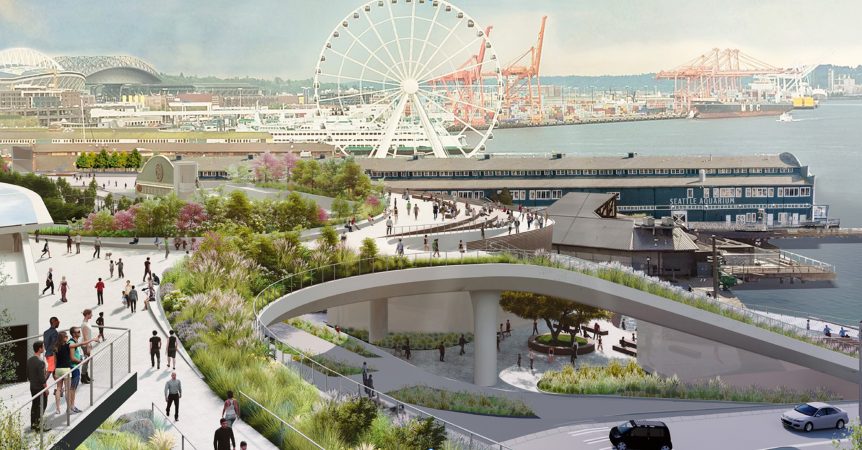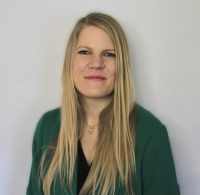Seattle's New Waterfront (Image credit Seattle Office of the Waterfront and Civic Projects)
Uncovering Denmark’s Influence on Seattle’s New Waterfront
Nov 01, 2024
SDF Interdisciplinary Master Studio Program by the University of Washington College of Built Environments
A cornerstone of the practice of philanthropy is to be able to measure the impact of investments made. As stewards of our founders' resources, at SDF we use both quantitative and qualitative measurements to assess how our grants are having the desired impact to fulfill our mission. In this example, we spotlight our long-standing partnership with the UW-College of Built Environments to illustrate how investing consistently in well-run programs over multiple years can have an out-sized impact — in this case on the development of the Seattle Waterfront. In addition, these investments by SDF helped leverage public resources for this extraordinary new addition to the city landscape. Our sincere thanks to Nancy Rottle for her leadership throughout the past decade.
In 2010, a group of 23 graduate students traveled to Denmark to embark on a Scan Design Foundation (SDF) Interdisciplinary Master Studio Program by the University of Washington College of Built Environments (UWCBE). This program would start a long chain of potential influence evident 14 years later in the transformation of Seattle’s New Waterfront.
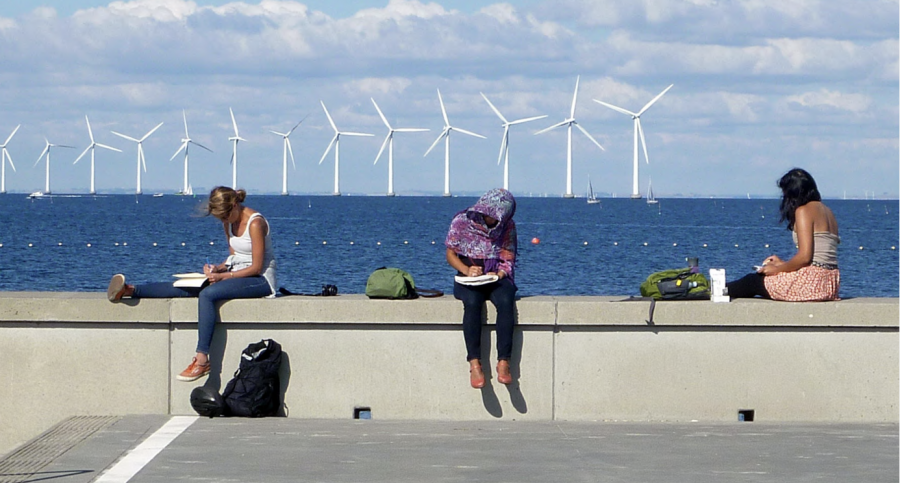
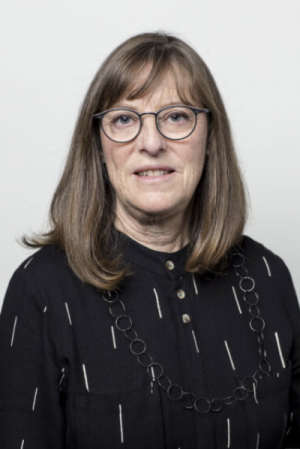
The SDF Interdisciplinary Master Studio program is the product of years of collaboration between SDF and UWCBE. It is a program that has been designed and expertly led by UW Professor Emeritus, Nancy Rottle. Rottle is the Director of the UW Green Future Research and Design Lab (GFL), and Professor Emeritus at the Department of Landscape Architecture nestled under UWCBE. The studio involves a two-week study tour in Denmark followed by a studio in Seattle at UW in the fall. It is guided in part by a seasoned Danish landscape architect or architect who meets the group in Copenhagen and then serves as a Distinguished Visiting Professor for the program during the fall quarter. Each year a theme is picked for the studio that is based on current land- or city-scape needs. Over the course of four of these past studios, Seattle’s New Waterfront project was in focus.
For the new waterfront project, the City of Seattle has removed the Alaskan Way Viaduct and is actively working to re-establish meaningful public spaces and healthier connections to Elliott Bay, while better connecting the waterfront to downtown Seattle. The Seattle Waterfront Plan envisions a series of public amenities along the waterfront, stretching from Pioneer Square to Belltown, which have recently been under construction. In October (2024), the Overlook Park that connects Pike Place Market to the waterfront and a new Seattle Aquarium addition opened to the public.
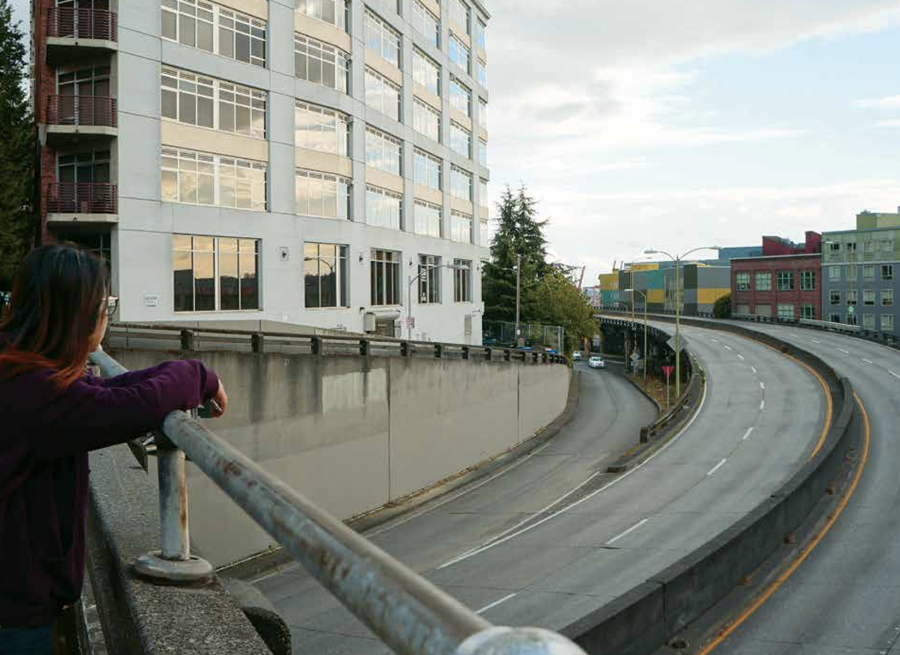
Since 2010, over 100 UWCBE graduate students have worked on projects related to the new waterfront in the Scan Design Foundation Interdisciplinary Studios led by Rottle and with guidance from Danish professionals. In addition to the 100 students, the program has involved graduate teaching assistants who were intimately involved with the travel and studio processes. Many of these UW graduates have moved on to work for the City of Seattle and for local architecture planning firms and have been involved in the extensive public outreach sponsored by the City’s Waterfront team.
While the Seattle waterfront design process was long and underwent many phases with diverse influences and dedicated involvement of countless individuals, the SDF/UWCBE Interdisciplinary Master Studios have likely played an influential role in inspiring and informing its transformation. The new design exhibits certain influences from these cross-cultural collaborations between Copenhagen and Seattle over the years. There is evidence that the project has benefited from the symbiotic exchange of ideas, connections, and research to support the waterfront’s expansive remake.
The Scan Design Foundation Interdisciplinary Master Studio Program has worked on the Seattle Waterfront in four studios — first on general planning in Autumn 2010, before a Landscape Architect consultant was hired. The studio then worked on more detailed design which included temporary pop-up activation on Pier 62-63 in Autumn 2011. A few years later, in 2014, the studios focused on the North segment of the Waterfront, which is still in the process of being designed. The studio has been featured in an exhibit at the Friends of the Waterfront office on Western Ave, and the early design in 2010 included visions for the Overlook Walk.
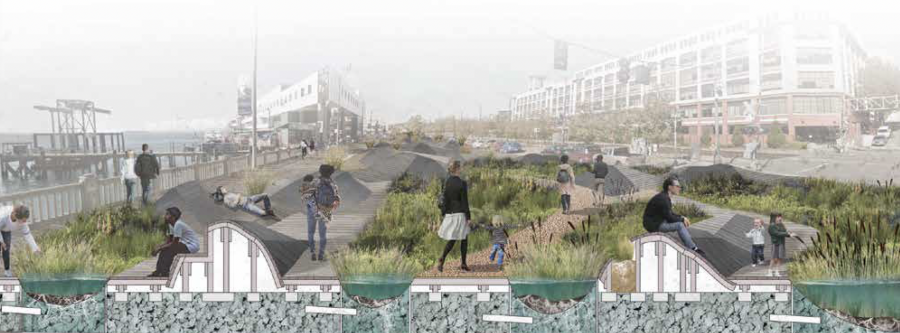
A human-centered approach: The SDF Interdisciplinary Denmark Study Tours focusing on the Waterfront have been led by Rottle her UW co-instructors, and further guided by the professional staff of Gehl Architects, Copenhagen's bicycle planners, and expert planners of the innovative Western Harbor project as well as other Danish urban designers and landscape architects. As part of the tours, several waterfronts were visited, analyzed and documented to inspire new ideas along Seattle's urban shoreline. Students applied urban analysis methods and a unique Danish design perspective used by Gehl Architects. Danish architects Bianca Hermansen and Louise Grassov from the internationally recognized firm worked directly with the students on site plans and design suggestions for the district, applying Gehl's working methods and principles. The interdisciplinary student teams proposed bold, well-considered solutions to the challenges of designing a human-centered and sustainable pedestrian space along Seattle's waterfront.
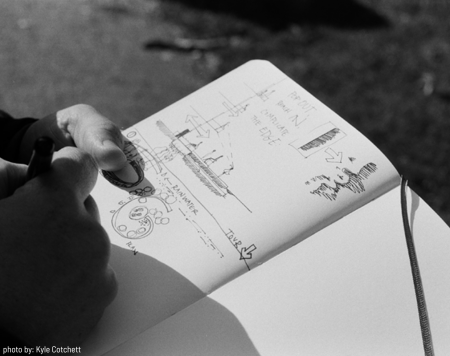
Data and knowledge sharing: The very first studio in 2008, Public Spaces Public Life for Seattle’s South Downtown, also took in the waterfront as a focus area. The studio had 31 students enrolled. It was connected to a Gehl/Green Futures Lab study on pedestrians and the quality of life Downtown. The data used was collected during the prior summer by the professional project. Gehl then hosted the first Scan Design Foundation Interns, who assisted with the firm’s final document for the City of Seattle, which lived for many years on the City’s website. The data collected influenced both the waterfront and the more recent work on the Pike/Pine Corridor.
Stormwater solutions: The focus of the 2017 studio was a stormwater-specific design, which included design proposals for the North waterfront. Rottle envisioned that the new waterfront spaces might help with Seattle’s stormwater pollution, which was being discharged directly into Elliott Bay. The Green Futures Lab received grants from the Russell Family Foundation and SeaGrant for a project to learn and envision how waterfronts might treat upstream polluted stormwater before discharging it into the bay. Notably, the Danish designs for artful stormwater management in Copenhagen were directly inspired by Seattle’s innovative “natural drainage” stormwater program. In 2012 SDF co-sponsored a program for Danish professionals to visit Seattle that included a tour and workshop led by Rottle to share solutions and further envision application of a Nature-based approach to stormwater management. The Danish “cloudburst” designs have since greatly expanded, impressively integrating artful application of stormwater design into their public spaces, which the students have been visiting in their study tours – exhibiting a full circle of knowledge exchange!
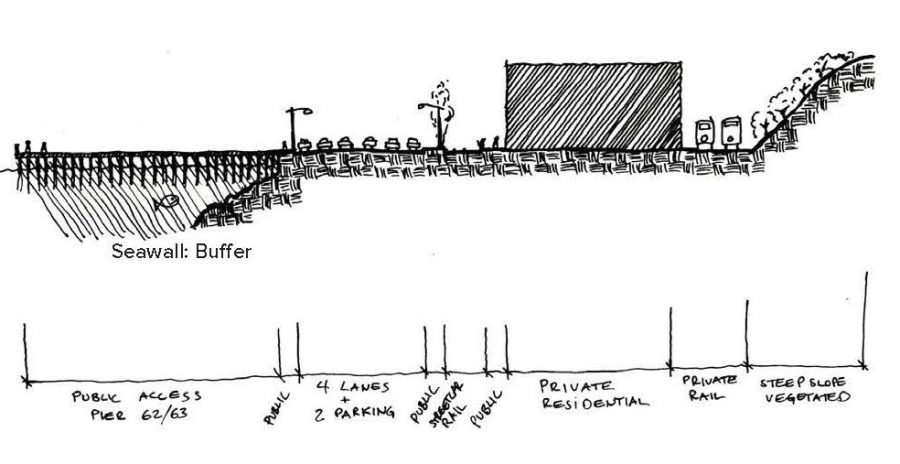
The traffic corridor: The decision to put through-traffic in a tunnel and not on Seattle Downtown streets came about after Rottle and Todd Vogel suggested that the City hire Gehl Architects to evaluate the impact of the nine viaduct replacement alternatives then under consideration. Todd was on the Waterfront Commission, and his firm and the UW Green Futures Lab (GFL) had just completed the Downtown Public Life study with Gehl. The pair realized that the City’s preferred alternative of channeling traffic to the Downtown would likely adversely affect both pedestrian and biking environments.
Gehl’s recommendation was that none of the nine alternatives were ideal, but that a tunnel with improvements to transit, biking and downtown streets and Alaskan Way was the best for public space and public life in the Downtown, as well as for the waterfront businesses. The ultimate outcome to construct the tunnel was highly influenced by Gehl’s expertise. This had a major influence on the waterfront space and development, as well as to Downtown Seattle.
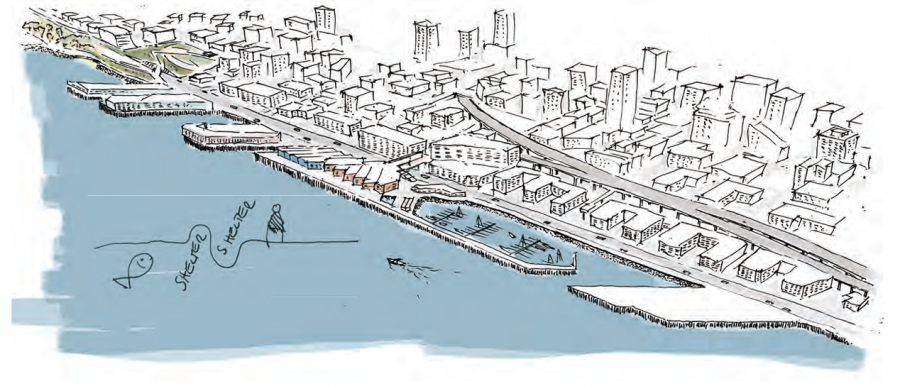
The Waterfront has been a massive project that has involved thousands of voices and taken decades of research to realize, including replacement of the failing seawall. The University of Washington has been a key contributor to the transformation, involving UW scientists, faculty, alumni, and students. These major contributions were published in an article in UW Magazine last summer and have been summarized here.
With funding from Scan Design Foundation, the University of Washington College of Built Environments and Green Futures Lab have been among those who have positively influenced the planning and design outcomes of our new Seattle Waterfront.
Blog credit:
Nancy D. Rottle, RLA, FASLA; Professor Emeritus, Department of Landscape Architecture; Director, UW Green Futures Research and Design Lab College of Built Environments
You can access the full studio books on the Scan Design Master Studio website here.
2010 (with Sharon Sutton), Public Spaces Public Life for Seattle’s Central Waterfront
2011 (with Kathryn Merlino), Public Spaces Public Life for Seattle’s Central Waterfront
2014 (with Jim Nichols), Blue Urbanism, Inviting Urban Play on Seattle’s North Waterfront
2017 Greener Belltown, Bluer Sound
